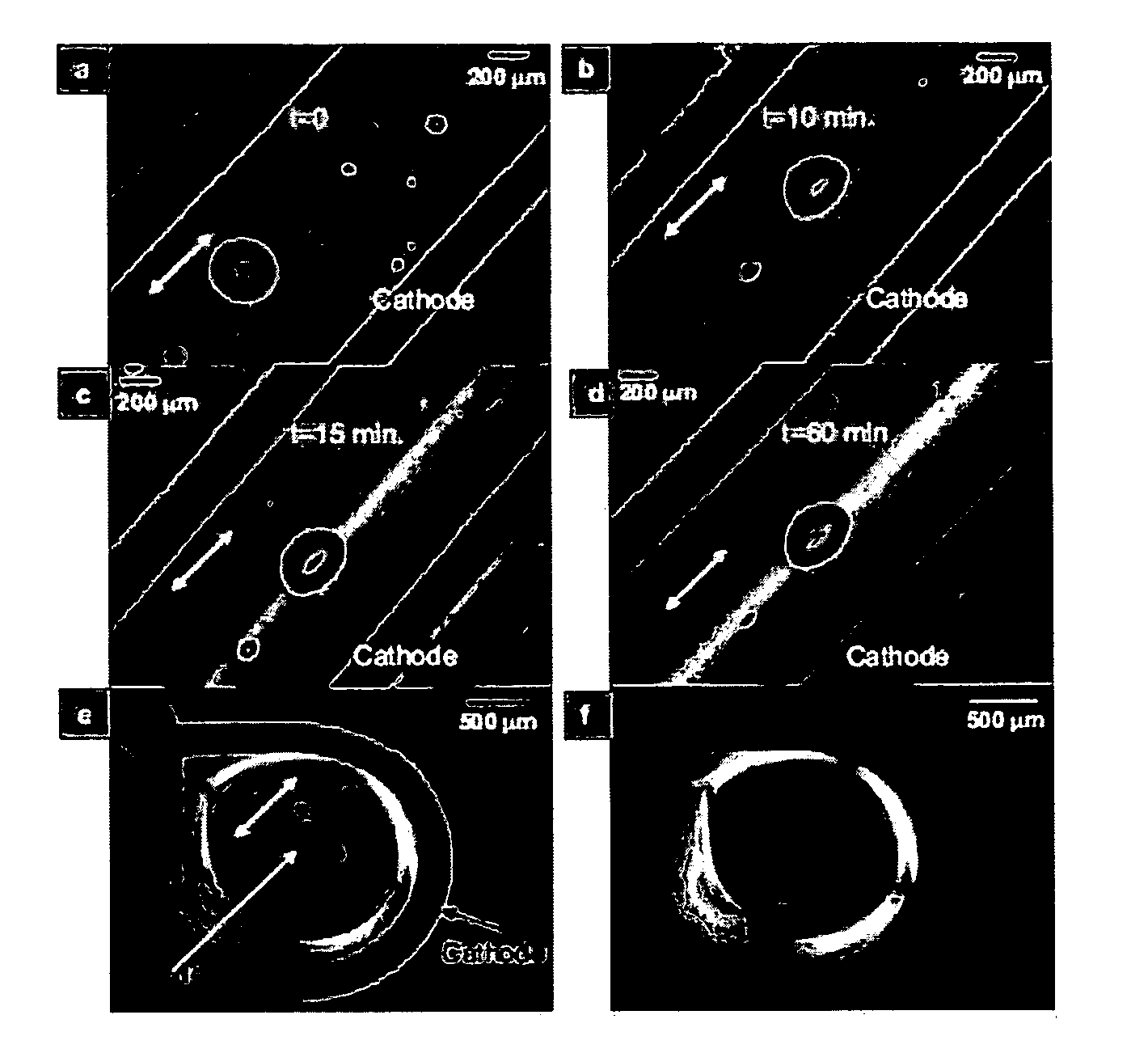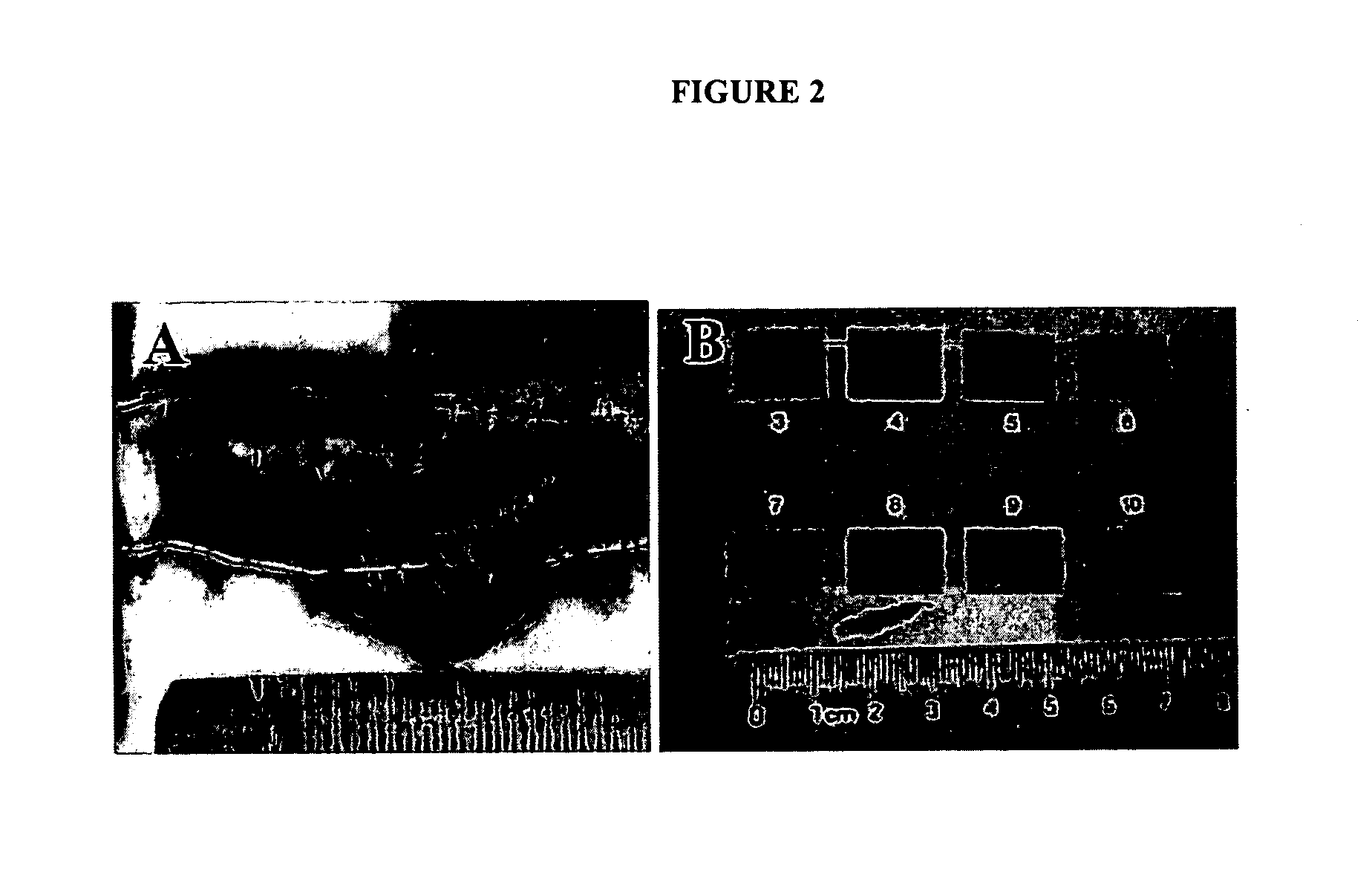Aligned collagen and method therefor
a technology of aligned collagen and constructs, which is applied in the direction of prosthesis, peptide/protein ingredients, microfluidic channels, etc., can solve the problems of inability to make macroscale collagenous constructs, and inability to achieve high packing density, etc., to achieve the effect of increasing the crosslinking density of the construct and low cos
- Summary
- Abstract
- Description
- Claims
- Application Information
AI Technical Summary
Benefits of technology
Problems solved by technology
Method used
Image
Examples
example 1
Electrochemical Alignment of Collagen
[0093]Ten mL of type-I collagen (6 mg / mL 97% bovine hide, INAMED Corporation, Santa Barbara, Calif.) was dialyzed (MWcut off=3.5 kDa) against ultrapure water at 5° C. for 72 hours to remove salts. The dialyzed collagen had the characteristics of normal acidic soluble monomeric collagen and did not undergo fibrillogenesis before the onset of the electrochemical process which took place at room temperature (FIG. 21). The dialyzed collagen underwent fibril formation only after the addition of 10× phosphate buffered saline (PBS) and adjustment of the temperature to 37° C. at pH 7.4 (FIG. 21). This indicates that the dialyzed collagen mainly existed in molecular form instead of fibrillar form at the onset of electric current application.
[0094]Two stainless steel electrode wires (0.003″ diameter, Sigmund Cohen Corporation, New York) were stripped of their insulating sheet along an inch-long segment and positioned parallel on a glass slide with separati...
example 2
Electrochemically-Induced Controlled Collagen Self-Assembly Process
[0103]The controlled collagen self-assembly process depicted in FIG. 7, Panel C, is composed of rotary alignment, isoelectric focusing and pH induced self-assembly. The mechanism of this process is also evident by time-elapsed polarized optical images acquired during electrochemically induced fibrillogenesis (FIG. 8, Panels A-D). The migration of collagen molecules towards the isoelectric point compressively deformed the shape of intentionally induced air bubbles from circular to elliptical. Also, the width of the collagen band increased with time and became more birefringent as all molecules aligned and assembled at the isoelectric point. The crystalline quality and orientation of the resulting collagen band was confirmed by its uniform and strong blue interference color when the collagen construct was viewed under crossed-polarizers coupled with a gypsum plate positioned at 45° (FIG. 8, Panels C-D). This indicates ...
example 3
Varying Geometry of Collagen Construct
[0104]To demonstrate the versatility of this electrochemical alignment technique for the generation of macroscale constructs of various shapes, a wire was bent into a circular cathode and a point-source anode was placed at the center of the ring (FIG. 14, Panel C). This configuration yielded a ring-shaped collagenous construct close to the cathode region. Using the gypsum plate and crossed-polarizers, it was confirmed that the molecules were circumferentially oriented within the ring, as evident by the blue and the yellow appearance in directions parallel and perpendicular to the slow axis of the gypsum plate, respectively (FIG. 8, Panel E). Without the gypsum plate, the collagen ring was highly birefringent under crossed-polarizers (FIG. 8, Panel F).
PUM
| Property | Measurement | Unit |
|---|---|---|
| density | aaaaa | aaaaa |
| current density | aaaaa | aaaaa |
| electric field strength | aaaaa | aaaaa |
Abstract
Description
Claims
Application Information
 Login to View More
Login to View More - R&D
- Intellectual Property
- Life Sciences
- Materials
- Tech Scout
- Unparalleled Data Quality
- Higher Quality Content
- 60% Fewer Hallucinations
Browse by: Latest US Patents, China's latest patents, Technical Efficacy Thesaurus, Application Domain, Technology Topic, Popular Technical Reports.
© 2025 PatSnap. All rights reserved.Legal|Privacy policy|Modern Slavery Act Transparency Statement|Sitemap|About US| Contact US: help@patsnap.com



